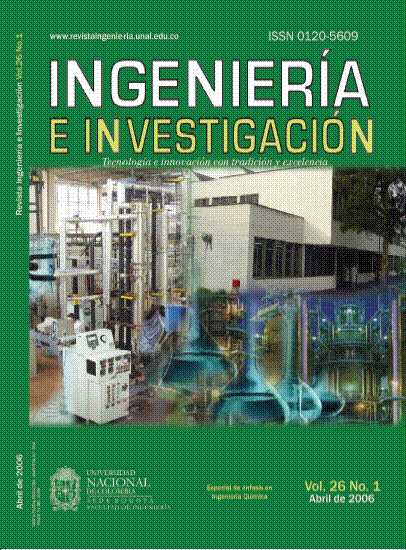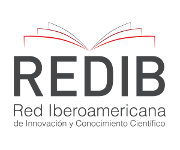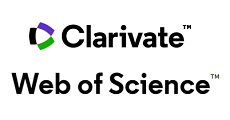Using an infrared probe for in situ monitoring of esterifying reactions
Empleo de una sonda infrarroja in situ para monitorear reacciones de esterificación
DOI:
https://doi.org/10.15446/ing.investig.v26n1.14681Keywords:
esterification, fatty acids, IR probe (en)esterificación, ácidos grasos, sonda Infrarroja (es)
Downloads
A batch reactor was employed having pH meter, IR probe and continuous operation detectors so that it could work as a CSTR reactor. As esterification advanced, then IR bands corresponding to the carboxyl acid COOH group and the alcohol C-OH group decreased whilst a parallel increase was presented in the ester -COOR group band which was forming. Reaction progress could be observed by continuous IR spectrum registration. The IR band for HOH (water) could not be studied because it needed a completely anhydrous medium for doing so. Standard solutions could be prepared for quantifying IR band peak intensity, according to a component's composition in the mixture. However, when phase changes occurred in the reaction mixture, this method could not be employed for following the course of a particular reaction because random variation was detected in band intensity.
Se empleó un reactor batch (por lotes), dotado de tres detectores: pH, Sonda IR y operación en continuo, de tal forma que puede operarse como un reactor CSTR. En la medida en que la esterificación procede, decrecen las bandas correspondientes al grupo -COOH del ácido carboxílico y la del grupo C-OH del alcohol, presentándose al mismo tiempo incremento en la banda del grupo -COOR del éster que se está formando. El progreso de la reacción se puede seguir por el registro continuo de los espectro IR. La banda correspondiente a H-O-H del agua no se puede seguir ya que se requiere de un ambiente absolutamente anhidro para hacerlo. De otro lado, por aparte pueden prepararse soluciones patrones para poder cuantificar la intensidad de los picos en el espectro IR, según la composición del componente en la mezcla. Sin embargo, cuando se presentan cambios de fase en la mezcla reactiva, este método no puede emplearse para seguir el curso de una reacción, ya que se presenta una variación muy aleatoria en la señal de intensidad de los picos.
References
Charles, J., The Aldrich Library, FI-IR spectros, Poncelet, Aldrich Chemical Co., Vols. I, II, 1985.
Groggins, P. H., Unit processes in Organic Synthesis, 5a Ed., McGraw Hill, 1958, pp. 697.
Katime, A., Síntesis y usos de hidrogeles, CYTED, Universidad del País Vasco, 1980.
Kolthoff, M., and Sandell, E. B., Textbook of quantitative inorganic analysis, 3a Ed., Ed. McMillan, New York, 1952, pp. 427-453.
Machado, F., y López, C. M., Tamiz molecular, CYTED, Dic. 1993.
MaClaurin, P, and Crabb, N. C., "Quantitative in situ monitoring of an elevated temperature reaction using a water-cooled mid-infrared fiber-optic probe", Anal. Chem., 68, 1996, pp. 1116-1123. DOI: https://doi.org/10.1021/ac9502965
Morrison, R. T., y Boyd, R. N., Química Orgánica. Ed. Addison Wesley Iberoamericana, México, 1987.
Sánchez, F, y Rodríguez, G., Esterificación., En Revista Ingeniería e Investigación, Facultad de Ingeniería, Universidad Nacional de Colombia, Bogotá, 33, 1996, pp. 19.
Vogel's Textbook of practical organic chemistry, 5a Ed., Editorial Longman, 1999.
Weast, R. C., CRC, Handbook of chemistry and physics, CRC Press, 1988, pp. D-101.
How to Cite
APA
ACM
ACS
ABNT
Chicago
Harvard
IEEE
MLA
Turabian
Vancouver
Download Citation
License
Copyright (c) 2006 Francisco José Sánchez Castellanos, Carlos Cesteros, Issa A Katime

This work is licensed under a Creative Commons Attribution 4.0 International License.
The authors or holders of the copyright for each article hereby confer exclusive, limited and free authorization on the Universidad Nacional de Colombia's journal Ingeniería e Investigación concerning the aforementioned article which, once it has been evaluated and approved, will be submitted for publication, in line with the following items:
1. The version which has been corrected according to the evaluators' suggestions will be remitted and it will be made clear whether the aforementioned article is an unedited document regarding which the rights to be authorized are held and total responsibility will be assumed by the authors for the content of the work being submitted to Ingeniería e Investigación, the Universidad Nacional de Colombia and third-parties;
2. The authorization conferred on the journal will come into force from the date on which it is included in the respective volume and issue of Ingeniería e Investigación in the Open Journal Systems and on the journal's main page (https://revistas.unal.edu.co/index.php/ingeinv), as well as in different databases and indices in which the publication is indexed;
3. The authors authorize the Universidad Nacional de Colombia's journal Ingeniería e Investigación to publish the document in whatever required format (printed, digital, electronic or whatsoever known or yet to be discovered form) and authorize Ingeniería e Investigación to include the work in any indices and/or search engines deemed necessary for promoting its diffusion;
4. The authors accept that such authorization is given free of charge and they, therefore, waive any right to receive remuneration from the publication, distribution, public communication and any use whatsoever referred to in the terms of this authorization.



























